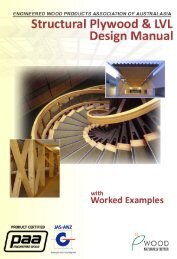Facts About Particleboard and MDF - Engineered Wood Products ...
Facts About Particleboard and MDF - Engineered Wood Products ...
Facts About Particleboard and MDF - Engineered Wood Products ...
You also want an ePaper? Increase the reach of your titles
YUMPU automatically turns print PDFs into web optimized ePapers that Google loves.
Joint treatment<br />
The treatment of the joints where two panels meet is very much a matter of taste but it is generally accepted<br />
that it is more effective to make a feature of the joint than to try hiding it or losing it.<br />
V Joint<br />
Suitable for all types of board but particularly plain or<br />
painted panels which can be nailed directly to battens.<br />
V Joints<br />
with<br />
Tongue<br />
Aluminium<br />
or PVC<br />
cover strip<br />
<strong>Wood</strong><br />
Insert<br />
V joints with ply tongue: Particularly suitable with<br />
decorative boards secret fix by skew pinning through the<br />
edge of the first board <strong>and</strong> pushing the next board into<br />
place. The centre of the board may be fixed to<br />
intermediate battens with adhesive.<br />
Extruded cover fillets: Aluminium or PVC strip glued in<br />
place. A T shaped extrusion is generally used but a fiat<br />
section applied to the face is also suitable. Nails or other<br />
fixings can be covered by the extrusion.<br />
Rebated joint: Board rebated <strong>and</strong> fixed through the<br />
rebate. Polished hardwood or painted soft-wood strip<br />
set into the rebate, either sunk below the surface or<br />
protruding above it <strong>and</strong> fixed by pinning or gluing .<br />
Open Joint<br />
Boards fixed to battens with (say) 12mm gap between<br />
them. The face of the batten may be painted or it may<br />
be faced with plastic strip or extrusion.<br />
Board Edging<br />
Edging of <strong>Particleboard</strong> <strong>and</strong> <strong>MDF</strong> is carried out to match or harmonise with surface treatment. With its tight,<br />
fibrous edge, <strong>MDF</strong> can be edge profiled <strong>and</strong> painted to match the colour scheme. <strong>Particleboard</strong> should have<br />
an edging applied.<br />
Boards can be edged or lipped in a variety of ways. Edges can be veneered easily to provide a matching finish<br />
to the surface. Provided that a clean saw cut has been made, further treatment of the edge surface is<br />
unnecessary. Veneers can be applied by h<strong>and</strong> or machine <strong>and</strong> the use of a urea-formaldehyde adhesive is<br />
suitable for most cases. An alternative edge details is to use a plastic strip with a toothed tongue on the back<br />
face which is pressed into a thin groove cut in the edge of the board.<br />
Solid wood lippings of any suitable width can be satisfactorily glued with a plain butt joint direct to a cleanly<br />
cut edge of <strong>Particleboard</strong>. Edged boards are offered by most manufacturers.<br />
A tongue <strong>and</strong> groove detail can be used but serves only to facilitate accurate location. Where this detail is<br />
used, the groove should be in the wood panel edge.<br />
Although lippings are normally applied after veneering of the surface, they can be satisfactorily applied<br />
before if required. In this case, the adhesive should be allowed to dry out thoroughly before veneering to<br />
ensure minimal risk of the joint line 'showing through'. Where edges are to be lipped after veneering, it is<br />
usual practice to use a slightly oversize lipping <strong>and</strong> s<strong>and</strong> down either by h<strong>and</strong> or drum s<strong>and</strong>er to provide a<br />
flush joint .<br />
27

















